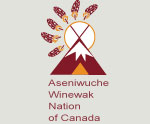Slide Shows
Students have an opportunity to view slideshows about the region of the Boreal Forest.
Art and Crafts
For thousands of years, the plants and animals of the boreal forest provided everything for the bushland people including all of the tools and clothes which they needed for survival; the arts and crafts which brought enjoyment to their lives; and the spiritual objects with which they practiced their religion. Unfortunately many of the skills required to make these arts and crafts are possessed by only a few elders. Nowadays, some traditional crafts are only practiced to preserve bushland culture, so that it may be handed down to the next generation.
Moccasins are the most common type of footwear used by the bushland people, and are worn by all members of the family year round. They are made from moose, deer, or caribou hide. The strongest hide to make moccasins from comes from a mature bull moose, but it also the most difficult hide to tan and sew. On special occasions people wear brightly decorated moccasins that feature leather fringes, fur trim, fish scale or porcupine quill beading, and embroidery.
Mukluks are soft boots. The bottom of a mukluk is similar to a moccasin, but the upper portion is made of moosehide, cloth, canvas, or fur. Mukluks come up to just below knee level and have room inside for several layers of warm fabric which makes them especially useful during the winter months.
Drums, especially hand-held drums are important in traditional bushland activities. Drums are usually about three feet in circumference and seven centimetres deep. The base of the drum is left open and it is played with bare hands, or beaten with a bone or willow stick. A drum is made by stretching a moosehide cover over a hoop of birch or spruce.
Other bushland arts and crafts come in the form of wall decorations made of birchbark and sweetgrass, carvings made of antlers, hide scrapers made from leg bone, hats and mitts made from beaver fur, purses made from fawn hide, necklaces made from fishscales, claws and teeth of various animals, birchbark baskets, grouse-gullet baby rattles, and fans made of ptarmigan tail feathers.
[ See the Slideshow ]
Burial Sites
Family members, friends, and ancestors of the bushland people are buried near traditional homes/cabins, and along abandoned trails. Most grave sites are marked only by trees, shrubs, and grasses instead of granite headstones. The grave sites in this slideshow are also gradually being overgrown. While they are difficult to see, they remain family and community landmarks. Aboriginal people buried their dead where they lived, so these sites are often found along traplines or at base camps and line cabins.
It is a traditional practice to leave an offering at the burial site. This is done to honour the memory of that person. The offering, known as kinnickinnick, is a natural form of tobacco, although in recent years it is not uncommon to offer factory made tobacco.
Grave markers are usually made of wood or stone found in the forest.
[ See the Slideshow ]
Log Cabins
People living on bush traplines call their home "camp", as in "Come to our camp" or "Tie your dogs at our camp". Every base camp is built on a river or lake. In the past there weren't many roads and waterways offered good transportation routes. Traditional Aboriginal houses were constructed out of logs, sod, bark, moss for the main frame and roof, animal skins for doors and windows, and soil and boughs of evergreens for flooring.
Home base is the main camp where a trapping family spends most of its time. The base camp is usually a single-room log home, but can be expanded with the addition of a porch or by adding extra rooms. Trapping families also have one or more line cabins. These act as temporary camps while the family is fishing, hunting, or trapping far from home.
In order to build the camp, trees, shrubs, and tall grasses are cleared away in the area around the home and between the building and the shoreline. Most of the homes are built above the flood plain of a river or lake to allow for good drainage. Building sites are also selected according to whether the family wants more sun in the morning or the evening.
Small line cabins were built at about twenty kilometre intervals along the trapline so that the families had shelter while they were away from the base camp. Sometimes tents were used as portable trapline shelters when line cabins weren't available. These tents were traditionally made from moose hides, but are now made from fabric like canvas.
[ See the Slideshow ]






